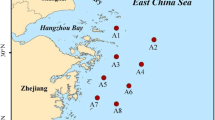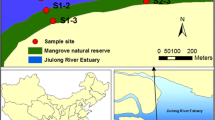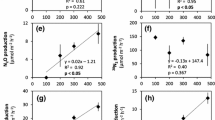Abstract
An increase in available nitrogen loading in intertidal ecosystems causes eutrophication and macroalgae blooms. Denitrification and anaerobic ammonium oxidation (anammox) lead to the removal of bioavailable nitrogen, but few studies have examined this in intertidal sediments. The sediment anammox and denitrification rates in September 2015 and November 2016 were measured using a 15N tracer technique at two sites, with and without macroalgae, in the hypereutrophic Yatsu tidal flat, eastern Japan. At both sites, the rate of N2 production via anammox was consistently low compared with that via denitrification, accounting for < 7% of the total N2 production. In a fed-batch incubation experiment, the anammox rate increased in the surface sediment after 3 months. However, the contribution of anammox to nitrogen removal did not exceed that of denitrification, suggesting that denitrification is the major pathway for conversion of inorganic nitrogen to N2, and that anammox plays a limited role in nitrogen removal in the Yatsu tidal flat. Denitrification activity measured from August 2012 to January 2017 using the acetylene block method was higher in the sediment with macroalgae than that without. Multiple linear regression analysis revealed that denitrification in the sediment with macroalgae was limited by the nitrogen substrate, likely due to competition with macroalgae for nitrogen. Temperature and H2S production under macroalgae cover might also affect denitrification. In comparison, the organic carbon content was a key factor regulating heterotrophic denitrification in the sediment without macroalgae. These findings suggest that the occurrence of macroalgae changes the progress of denitrification in intertidal ecosystems.



Similar content being viewed by others
References
Amano, T., I. Yoshinaga, K. Okada, T. Yamagishi, S. Ueda, A. Obuchi, Y. Sako, and Y. Suwa. 2007. Detection of anammox activity and diversity of anammox bacteria-related 16S rRNA genes in coastal marine sediment in Japan. Microbes and Environments 22 (3): 232–242. https://doi.org/10.1264/jsme2.22.232.
Amano, T., I. Yoshinaga, T. Yamagishi, C.V. Thuoc, P.T. Thu, S. Ueda, K. Kato, Y. Sako, and Y. Suwa. 2011. Contribution of anammox bacteria to benthic nitrogen cycling in a mangrove forest and shrimp ponds, Haiphong, Vietnam. Microbes and Environments 26 (1): 1–6. https://doi.org/10.1264/jsme2.ME10150.
Babbin, A.R., R.G. Keil, A.H. Devol, and B.B. Ward. 2014. Organic matter stoichiometry, flux, and oxygen control nitrogen loss in the ocean. Science 344: 406–408. https://doi.org/10.1126/science.1248364.
Bartoli, M., G. Castaldelli, D. Nizzoli, and P. Viaroli. 2012. Benthic primary production and bacterial denitrification in a Mediterranean eutrophic coastal lagoon. Journal of Experimental Marine Biology and Ecology 438: 41–51. https://doi.org/10.1016/j.jembe.2012.09.011.
Bendschneider, K., and R.J. Robinson. 1952. A new spectrophotometric method for the determination of nitrite in sea water. Journal of Marine Research 11: 87–96.
Bonaglia, S., I. Klawonn, L. De Brabandere, B. Deutsch, B. Thamdrup, and V. Brüchert. 2016. Denitrification and DNRA at the Baltic Sea oxic-anoxic interface: substrate spectrum and kinetics. Limnology and Oceanography 61 (5): 1900–1915. https://doi.org/10.1002/lno.10343.
Brin, L.D., A.E. Giblin, and J.J. Rich. 2014. Environmental controls of anammox and denitrification in southern New England estuarine and shelf sediments. Limnology and Oceanography 59: 851–860. https://doi.org/10.4319/lo.2014.59.3.0851.
Capone, D.G., D.A. Bronk, M.R. Mulholland, and E.J. Carpenter. 2008. Nitrogen in the marine environment, 2nd edn. Estuaries. ISBN: 978-0-12-372522-6.
Corzo, A., S.A. van Bergeijk, and E. Garciá-Robledo. 2009. Effects of green macroalgal blooms on intertidal sediments: net metabolism and carbon and nitrogen contents. Marine Ecology Progress Series 380: 81–93. https://doi.org/10.3354/meps07923.
Dalsgaard, T. 2003. Benthic primary production and nutrient cycling in sediments with benthic microalgae and transient accumulation of macroalgae. Limnology and Oceanography 48 (6): 2138–2150. https://doi.org/10.4319/lo.2003.48.6.2138.
Dalsgaard, T., B. Thamdrup, and D.E. Canfield. 2005. Anaerobic ammonium oxidation (anammox) in the marine environment. Research in Microbiology 156 (4): 457–464. https://doi.org/10.1016/j.resmic.2005.01.011.
Damashek, J., and C.A. Francis. 2018. Microbial nitrogen cycling in estuaries: from genes to ecosystem processes. Estuaries and Coasts 41 (3): 626–660. https://doi.org/10.1007/s12237-017-0306-2.
De Brabandere, L., D.E. Canfield, T. Dalsgaard, G.E. Friederich, N.P. Revsbech, O. Ulloa, and B. Thamdrup. 2014. Vertical partitioning of nitrogen-loss processes across the oxic-anoxic interface of an oceanic oxygen minimum zone. Environmental Microbiology 16 (10): 3041–3051. https://doi.org/10.1111/1462-2920.12255.
Galloway, J.N., F.J. Dentener, D.G. Capone, E.W. Boyer, R.W. Howarth, S.P. Seitzinger, G.P. Asner, C.C. Cleveland, P.A. Green, E.A. Holland, D.M. Karl, A.F. Michaels, J.H. Porter, A.R. Townsend, and C.J. Vorosmarty. 2004. Nitrogen cycles: past, present, and future. Biogeochemistry 70 (2): 153–226. https://doi.org/10.1007/s10533-0040370-0.
Hansen, J.I., K. Henriksen, and T.H. Blackburn. 1981. Seasonal distribution of nitrifying bacteria and rates of nitrification in coastal marine sediments. Microbial Ecology 7 (4): 297–304. https://doi.org/10.1007/BF02341424.
Hou, L., Y. Zheng, M. Liu, J. Gong, X. Zhang, G. Yin, and L. You. 2013. Anaerobic ammonium oxidation (anammox) bacterial diversity, abundance, and activity in marsh sediments of the Yangtze estuary. Journal of Geophysical Research: Biogeosciences 118 (3): 1237–1246. https://doi.org/10.1002/jgrg.20108.
Howarth, R., F. Chan, D.J. Conley, J. Garnier, S.C. Doney, and R. Marino. 2011. Coupled biogeochemical cycles: eutrophication and hypoxia in temperate estuaries and coastal marine ecosystems. Frontiers in Ecology and the Environment 9 (1): 18–26. https://doi.org/10.1890/100008.
Isobe, K., Y. Suwa, J. Ikutani, M. Kuroiwa, T. Makita, Y. Takebayashi, M. Yoh, S. Otsuka, K. Senoo, M. Ohmori, and K. Koba. 2011. Analytical techniques for quantifying 15N/14N of nitrate, nitrite, total dissolved nitrogen and ammonium in environmental samples using a gas chromatograph equipped with a quadrupole mass spectrometer. Microbes and Environments 26 (1): 4653–4653. https://doi.org/10.1264/jsme2.ME10159.
Jørgensen, B.B. 1977. The sulfur cycle of a coastal marine sediment (Limfjorden, Denmark). Limnology and Oceanography 22 (5): 814–832. https://doi.org/10.4319/lo.1977.22.5.0814.
Joye, B.B., and J.T. Hollibaugh. 1995. Influence of sulfide inhibition of nitrification on nitrogen regeneration in sediments. Science 270 (5236): 623–625. https://doi.org/10.1126/science.270.5236.623.
Koop-Jakobsen, K., and A.E. Giblin. 2009. Anammox in tidal marsh sediments: the role of salinity, nitrogen loading, and marsh vegetation. Estuaries and Coasts 32 (2): 238–245. https://doi.org/10.1007/s12237-008-9131-y.
Lam, P., and M.M.M. Kuypers. 2011. Microbial nitrogen cycling processes in oxygen minimum zones. Annual Review of Marine Science 3 (1): 317–345. https://doi.org/10.1146/annurev-marine-120709-142814.
Lisa, J.A., B. Song, C.R. Tobias, and D.E. Hines. 2015. Genetic and biogeochemical investigation of sedimentary nitrogen cycling communities responding to tidal and seasonal dynamics in Cape Fear River estuary. Estuarine, Coastal and Shelf Science 167: A313–A323. https://doi.org/10.1016/j.ecss.2015.09.008.
Lomstein, B.A., L.B. Guldberg, A.T.A. Neubauer, J. Hansen, A. Donnelly, R.A. Herbert, P. Viaroli, G. Giordani, R. Azzoni, R. de Wit, and K. Finster. 2006. Benthic decomposition of Ulva lactuca: a controlled laboratory experiment. Aquatic Botany 85 (4): 271–281. https://doi.org/10.1016/j.aquabot.2006.05.006.
McManus, J., W.M. Berelson, K.H. Coale, K.S. Johnson, and T.E. Kilgore. 1997. Phosphorus regeneration in continental margin sediments. Geochimica et Cosmochimica Acta 61 (14): 2891–2902. https://doi.org/10.1016/S0016-7037(97)00138-5.
Meyer, R.L., N. Risgaard-Petersen, and D.E. Allen. 2005. Correlation between anammox activity and microscale distribution of nitrite in a subtropical mangrove sediment. Applied and Environmental Microbiology 71 (10): 6142–6149. https://doi.org/10.1128/AEM.71.10.6142-6149.2005.
Mulder, A., A.A. Vandegraaf, L.A. Robertson, and J.G. Kuenen. 1995. Anaerobic ammonium oxidation discovered in a denitrifying fluidized-bed reactor. FEMS Microbiology Ecology 16 (3): 177–183. https://doi.org/10.1111/j.1574-6941.1995.tb00281.x.
Murphy, J., and J.P. Riley. 1962. A modified single solution method for the determination of phosphate in natural waters. Analytica Chimica Acta 27: 31–36.
Nedergaard, R.I., N. Risgaard-Petersen, and K. Finster. 2002. The importance of sulfate reduction associated with Ulva lactuca thalli during decomposition: a mesocosm experiment. Journal of Experimental Marine Biology and Ecology 275 (1): 15–29. https://doi.org/10.1016/S0022-0981(02)00211-3.
Nielsen, L.P. 1992. Denitrification in sediment determined from nitrogen isotope pairing. FEMS Microbiology Ecology 86 (4): 357–362. https://doi.org/10.1111/j.1574-6968.1992.tb04828.x.
Payne, W.J. 1973. Reduction of nitrogenous oxides by microorganisms. Bacteriological Reviews 37 (4): 409–452.
R Development Core Team 2015. R: a language and environment for statistical computing. Vienna: R Foundation for Statistical Computing. ISBN 3–900051–07-0, URL http://www.R-project.org.
Risgaard-Petersen, N., R.L. Meyer, M. Schmid, M.S.M. Jetten, A. Enrich-Prast, S. Rysgaard, and N.P. Revsbech. 2004. Anaerobic ammonium oxidation in an estuarine sediment. Aquatic Microbial Ecology 36: 293–304. https://doi.org/10.3354/ame036293.
Rysgaard, S., N. Risgaard-Petersen, N.P. Sloth, K. Jensen, and L.P. Nielsen. 1994. Oxygen regulation of nitrification and denitrification in sediments. Limnology and Oceanography 39 (7): 1643–1652. https://doi.org/10.4319/lo.1994.39.7.1643.
Sagi, T. 1966. Determination of ammonia in sea water by the indophenol method and its application to the coastal and off-shore waters. Oceanography Magagine 18: 43–51.
Seitzinger, S.P. 1988. Denitrification in freshwater and coastal marine ecosystems: ecological and geochemical significance. Limnology and Oceanography 33 (4part2): 702–724. https://doi.org/10.4319/lo.1988.33.4part2.0702.
Senga, Y., Y. Seike, K. Mochida, K. Fujinaga, and M. Okumura. 2001. Nitrous oxide in brackish lakes Shinji and Nakaumi, Japan. Limnology 2 (2): 129–136. https://doi.org/10.1007/s102010170008.
Senga, Y., K. Mochida, R. Fukumori, N. Okamoto, and Y. Seike. 2006. N2O accumulation in estuarine and coastal sediments: the influence of H2S on dissimilatory nitrate reduction. Estuarine, Coastal and Shelf Science 67 (1-2): 231–238. https://doi.org/10.1016/j.ecss.2005.11.021.
Senga, Y., M. Okumura, and Y. Seike. 2010. Seasonal and spatial variation in the denitrifying activity in estuarine and lagoonal sediments. Journal of Oceanography 66 (1): 155–160. https://doi.org/10.1007/s10872-010-0013-0.
Shiraki, Y., T. Kitazawa, S. Lee, and Y. Senga. 2018. A method for determining Batillaria attramentaria distribution using aerial balloon photography and a vegetation index camera: demonstration at the Yatsu tidal flat, Chiba Prefecture. Advances in Remote Sensing 7 (01): 15–24. https://doi.org/10.4236/ars.2018.71002.
Sørensen, J., J.M. Tiedje, and R.B. Firestone. 1980. Inhibition by sulfide of nitric and nitrous oxide reduction by denitrifying Pseudomonas fluorescens. Applied and Environmental Microbiology 39 (1): 105–108.
Sørensen, J., L.K. Rasmussen, and I. Koike. 1987. Micromolar sulfide concentrations alleviate acetylene blockage of nitrous oxide reduction by denitrifying Pseudomonas fluorescens. Canadian Journal of Microbiology 33 (11): 1001–1005. https://doi.org/10.1139/m87-176.
Tam, T.-Y., and R. Knowles. 1979. Effects of sulfide and acetylene on nitrous oxide reduction by soil and Pseudomonas aeruginosa. Canadian Journal of Microbiology 25 (10): 1133–1138. https://doi.org/10.1139/m79-176.
Thamdrup, B., and T. Dalsgaard. 2002. Production of N2 through anaerobic ammonium oxidation coupled to nitrate reduction in marine sediments. Applied and Environmental Microbiology 68 (3): 1312–1318. https://doi.org/10.1128/AEM.68.3.1312-1318.2002.
Trimmer, M., D.B. Nedwell, D.B. Sivyer, and S.J. Malcolm. 2000. Seasonal organic mineralization and denitrification in intertidal sediments and their relationship to the abundance of Enteromorpha sp. and Ulva sp. Marine Ecology Progress Series 203: 67–80. https://doi.org/10.3354/meps203067.
Trimmer, M., J.C. Nicholls, and B. Deflandre. 2003. Anaerobic ammonium oxidation measured in sediments along the Thames estuary, United Kingdom. Applied and Environmental Microbiology 69 (11): 6447–6454. https://doi.org/10.1128/AEM.69.11.6447-6454.2003.
van de Graaf, A.A., A. Mulder, P. Debruijn, M.S.M. Jetten, L.A. Robertson, and J.G. Kuenen. 1995. Anaerobic oxidation of ammonium is a biologically mediated process. Applied and Environmental Microbiology 61 (4): 1246–1251.
van de Graaf, A.A., P. deBruijn, L.A. Robertson, M.S.M. Jetten, and J.G. Kuenen. 1996. Autotrophic growth of anaerobic ammonium-oxidizing micro-organisms in a fluidized bed reactor. Microbiology 142 (8): 2187–2196.
Wada, S., and T. Hama. 2013. The contribution of macroalgae to the coastal dissolved organic matter pool. Estuarine, Coastal and Shelf Science 129: 77–85. https://doi.org/10.1016/j.ecss.2013.06.007.
Wetzel, P.G. 2001. 23 Detritus: organic carbon cycling and ecosystem metabolism. In Limnology, lake and river ecosystems, 731–783. Elsevier Inc.
Wood, E.D., F.A.J. Armstrong, and F.A. Richards. 1967. Determination of nitrate in sea water by cadmium-copper reduction to nitrate. Journal of Marine Biological Association of the United Kingdom 47: 23–31.
Yabe, T., Y. Ishii, Y. Amano, T. Koga, S. Hayashi, S. Nohara, and H. Tatsumoto. 2009. Green tide formed by free-floating Ulva spp. at Yatsu tidal flat, Japan. Limnology 10 (3): 239–245. https://doi.org/10.1007/s10201-009-0278-4.
Yoshimura, M., and S. Yamochi. 2011. Research on the seasonal succession of green tide and tolerance of a causative seaweed Ulva ohnoi to low salinity and desiccation at the north pond of Osaka Nanko Bird Sanctuary (In Japanese, with English abstract). 67:I_1136–I_1140. https://doi.org/10.2208/kaigan.67.I_1136.
Yoshinaga, I., T. Amano, T. Yamagishi, K. Okada, S. Ueda, Y. Sako, and Y. Suwa. 2011. Distribution and diversity of anaerobic ammonium oxidation (anammox) bacteria in the sediment of a eutrophic freshwater lake, Lake Kitaura, Japan. Microbes and Environments 26 (3): 189–197. https://doi.org/10.1264/jsme2.ME10184.
Yoshinari, T., and R. Knowles. 1976. Acetylene inhibition of nitrous oxide reduction by denitrifying bacteria. Biochemical Biophysical Research Communications 69 (3): 705–710.
Yoshinari, T., R. Hynes, and R. Knowles. 1977. Acetylene inhibition of nitrous oxide reduction and measurement of denitrification and nitrogen fixation in soil. Soil Biology and Biochemistry 9 (3): 177–183.
Acknowledgments
We thank Kazuichi Isaka, Nobuyuki Aiko, and Kentaro Hayashi for their helpful discussion.
Funding
This work was supported by the Japan Society for the Promotion of Science KAKENHI, grant number JP15K00525.
Author information
Authors and Affiliations
Corresponding author
Additional information
Communicated by Lijun Hou
Rights and permissions
About this article
Cite this article
Senga, Y., Sato, T., Kuroiwa, M. et al. Anammox and Denitrification in the Intertidal Sediment of the Hypereutrophic Yatsu Tidal Flat, Japan. Estuaries and Coasts 42, 665–674 (2019). https://doi.org/10.1007/s12237-019-00520-6
Received:
Revised:
Accepted:
Published:
Issue Date:
DOI: https://doi.org/10.1007/s12237-019-00520-6




